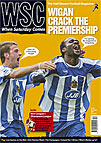 Fans who want a return to terracing are not content to sit in silence while they wait, explains Amanda Matthews
Fans who want a return to terracing are not content to sit in silence while they wait, explains Amanda Matthews
Memories of standing on the terraces are now fast fading in the Premiership. Young fans are more likely than not to sit in the stands and watch their team in near silence. But members of “Stand Up Sit Down” feel all-seat stadiums and being made to sit contribute hugely to the lack of atmosphere, and that that is increasingly influencing fans’ decisions to stay away.
At Man City supporters have “the Atmosphere Action Group”; at Newcastle, “Bring Back the Noise”. The efforts of the City fans are perhaps paying off; at a recent home game a recording of the crowd in full voice was heard over the public-address system…
SUSD would welcome the return of safe terracing along the German model, but recognise that most clubs would be loath to put the necessary investment into doing this even if the law was changed. We therefore propose that the authorities consider relaxing the rules and allow fans to stand in front of their seats in designated areas, preferably a lower tier, something that they have done without incident since seats replaced terraces.
There have been unofficial standing areas for years – the Bobby Moore Lower at the Boleyn Ground and the Kop at Anfield, for example. It is no coincidence that these parts of the ground generate the noisiest and most passionate atmosphere. These areas survive despite initiatives by clubs driven by the local authorities and the Football Licensing Authority (FLA).
Many in the media were moved to comment on the magnificent support Portsmouth gave their team while standing one wet, miserable night when they were on the receiving end of a 5-0 thrashing from Arsenal, yet such support used to be commonplace. The FLA are placing growing pressure on clubs and local authorities to ensure supporters remain seated for the duration of the game apart from at “moments of high excitement”. Safety officers’ definition of this term varies dramatically from club to club, with some stewards cracking down on supporters standing, for example, during a corner. This pressure has resulted in threats to close parts of grounds, while some clubs have had away ticket allocations reduced, dependent on the local authority responsible for the stadium. Tottenham recently banned some supporters for three games as a punishment for persistent standing; many others had season tickets confiscated and have been told they are no longer welcome at their club.
At SUSD we’ve spoken to a number of people within the game, including club chairmen, safety officers and individual police officers, who back our objectives. Yet very few will allow us to quote them on the record as they fear a reaction from the FLA and safety authorities. Last season the managing director of a Championship club voiced support for our initiative and urged fans to do likewise. Shortly afterwards that he was told by his local safety advisory group that his opinions on the issue should not be aired.
When SUSD met the FLA earlier this year, they simply disregarded our arguments by referring to the risk of fans losing their balance and falling: “because a cascade effect (or similar) has never happened, that does not mean to say it won’t and we have to use all our powers to stop it happening”. Sports Minister Richard Caborn stated that supporter safety is more important than giving us the choice as to whether we sit or stand. But surely, if the risk of “cascading” was so great, then every supporter in the country would be legally required to spend the entire 90 minutes stuck to their seats?
Many grounds hosted rock concerts during the summer, at which audiences were not subjected to any of the regulations applied to football supporters. If even a small minority of football fans behaved in the same way as Oasis fans during their concert at the City of Manchester Stadium – climbing from an upper tier to a lower one, for example – then there would be calls for games to be played behind closed doors. We’ve been told by the FLA that concert-goers’ “profile” differs from that of football supporters and a similar reason is given to explain away why some Europeans can stand: they supposedly have a “different supporting culture” to us. Simply, it seems that a concerted effort is being made to prevent this issue being debated publicly.
If the game’s authorities were to consider the return of standing, either by implementing our proposals or taking away seats that were simply put on terraces, they should look at a survey carried out on our proposals by the Football Fans’ Census last year. Just over 1,500 fans from all clubs were surveyed and 88 per cent of them said separate standing areas should be created, with a further 24 per cent saying they should be mandatory. While such strong opinions are ignored by club officials who haven’t offered a convincing argument in favour of the all-seat rule, supporters will continue to watch games in the pub instead.
A total ban on standing can’t be justified on the grounds of safety, crowd control or customer care. It is time to accept that the current regulations are unworkable and to allow managed standing in the most suitable areas.
From WSC 226 December 2005. What was happening this month